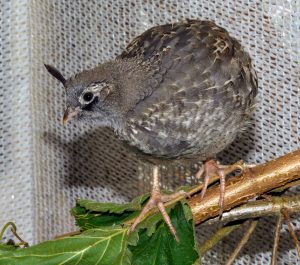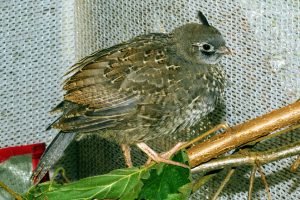Support Us
Since 1979 more than 140,000 animals have been treated by Wildlife Rescue.
Thanks to the support of individuals like you, Wildlife Rescue can provide a lifeline for animals in distress.
In late May, a finder came across a nest containing two California Quail babies in the interior region of Osoyoos, BC. The kind-hearted individual rescued the possible orphans and kept them warm overnight before driving them to Wildlife Rescue hospital for care.

Introduced to Osoyoos as game birds, California Quails have certainly adapted to their environment – their distinct plumage has made them a staple of the Okanagan. Small and round, these birds have square tails and a scales patterns with white, brown, and beige feathers on their stomachs. Found in both rural and urban environments, California Quails make inconspicuous nests (often surrounded by rocks) in grass or at the foot of trees. California Quails also “egg dump”, where females lay eggs in nests that are not their own – which often leads to large numbers of eggs per nest. To stay safe, these birds group together to form coveys during the fall and winter and tend to stay in bushes during the summer months to avoid both the sun and predators.
Challenges They Face
Unfortunately, California Quails face numerous obstacles in their natural and urban environments. Since California Quails are such promising targets, many predators (including cats) will aim for them. California Quail nests are often low to the ground, curious humans can disturb nests or even damage them unknowingly. These quail are losing habitats in urban environments. California Quails rely on bushes and trees – and when they are trimmed/cut down, they lose a nesting spot.
Road to Recovery for California Quail
Staff and volunteers have worked hard in the last 3 weeks, providing, much-needed warmth and a nutritional diet of seeds, chick mix, and insects to ensure these babies can make it into adulthood and safely return home.
They are now half their adult weight and are growing their flight feathers and crest feathers.
The recently rescued quails are learning how to fly, perch, forage, and defend themselves to survive on their own. To prepare for their pre-release conditioning in a few weeks after they develop their feathers, the quails will progress to a larger outdoor aviary where they can work on flying more extensively. They will now have an opportunity to grow and survive.

How to Help
There are a few simple things we can do to help California Quail like ….
• Keeping cats indoors helps to keep both cats and birds safe
• Avoiding trimming hedges during spring and summer, so California Quail and wildlife will be able to use them to nest and seek cover
• Call a wildlife rehabilitator if you see an orphaned bird as the good Samaritan did. Seek advice first before scooping up baby birds or mammals, their behaviour might be part of their natural development
We can also help birds in need. If you see an injured bird that has exposed bone or blood, no feathers, bugs, or insects covering it, or is sleeping, human intervention is required. Please contact our Support Centre for assistance.